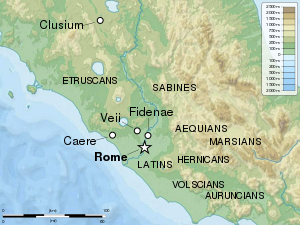Aequi

The Aequi were an
Historical geography
The historians made many entries concerning the wars between the Aequi and Rome; the geographers scarcely mention them.
They occupied the upper reaches of the valleys of the
History
According to
They fought several wars against the Romans, among which was the Battle of Mount Algidus (458 BC). Their chief center is said to have been taken by the Romans about 484 BC.[7] and again about 90 years later.[8]
Records of fighting between Romans and Aequi become much sparser in the second half of the 5th century BC. Likely the Aequi had gradually become a more settled people and their raiding petered out as a result.[9]
In 390 BC, a Gaulish war band defeated the Roman army at the
The Aequi were not finally subdued until the end of the second Samnite war,[14] when they seem to have received a limited form of franchise.[15]
All we know of their subsequent political condition is that after the
At the end of the Republican period, the Aequi appear under the name Aequiculi or Aequicoli, organized as a municipium, the territory of which seems to have comprised the upper part of the valley of the
References
- ^ a b Conway, Robert Seymour (1897). The Italic Dialects. Cambridge: Cambridge University Press. pp. 301–305.
- ^ Pliny the Elder. "Book III, Chapter 12". Natural History.
- ^ Ptolemy. "Book III, Chapter 1". Geography.
- ^ Strabo. "Book V, Chapter 3, Section 2 (C 229)". Geography.
- Ab urbe condita, 1:32
- Ab urbe condita, 1:55
- ^ D.S. xi.140
- ^ D.S. xiv.106
- ISBN 978-0-415-01596-7.
- ^ Livy, 6.2.14; Plutarch, Camillus 33.1, 35.1
- ^ D.S., xiv.117.4
- ^ Livy, 6.4.8
- ISBN 0-19-815277-9.
- ^ Livy, 9:45, 10:1; Diod. xx. 101
- ^ Cicero, Off. i. n, 35
- ^ C.I.L. ix. p. 388
- This article incorporates text from a publication now in the public domain: Chisholm, Hugh, ed. (1911). "Aequi". Encyclopædia Britannica (11th ed.). Cambridge University Press.
